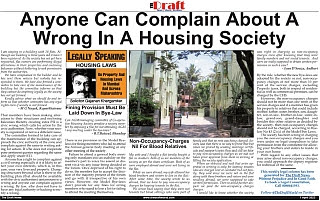Street Art Boosts Awareness, Rid Hawkers and Help Artists
Manu Shrivastava | Mumbai
After having changed the landscape of Navi Mumbai Municipal Corporation's (NMMC), subways and walls making riding under the subways a 'colourful' breeze, the street artists have now descended upon Mumbai's Colaba area to make waves.
Most of the street artists comprise film poster painters who lost their livelihood from 2000 with the onset of digital printing technologies and those who were hit rather critically with the onset of the lockdown in 2020. And then, there are students, volunteers and professionals keen on making their mark felt on the streets of India’s financial capital.
 |
| TALENTED: Tribal artist Sapna Patil at work in Navi Mumbai |
“We’re all set to make Colaba, the art capital of Mumbai,” says BMC Corporator from Ward 227 Makarand Narwekar who feels strongly for the issue. “It’s a Win-Win situation for us all. While the idea is to reclaim the public space for the public, the art will not just help beautify the place. The move is part of an endeavour to rid the zones of beggars, illegal hawkers, pesky encroachers and ensure safety of the residents too.”
So, in the first phase, in Colaba, few zones have been selected for the street art which have now transformed from being encroached by mechanics and hawkers into a brightly-lit colourful thoroughfare road where now walkers stroll by to take in Three-Dimensional views of the city’s heritage structures.
“The place should be cleared of hawkers as the all-important access road is almost impossible to travel by foot,” says Colaba resident Dorothy Yazdegardi.
 |
| ISSUES: The Badhwar Park lane to be painted lies peppered with beggars and illegal hawkers |
“The project will make the zone appealing. Besides ensuring that the places painted light up the zone, they must deter lumpen elements and be safer for women passersby,” offers a Colaba resident.
In Colaba, each wall selected for the art work has a specific theme. For example, the walls at DSK Durgamata Lane depict heritage of the city, the art work on the Army Wall on Wodehouse Road focus on the Indian Army, etc.
On the works undertaken in Navi Mumbai earlier this year, Navi Mumbai Municipal Corporation (NMMC) Additional Municipal Commissioner Sujata Dhole, who took charge in March 2020 says, “We’re trying to beautify zones across the city. The work started in December 2020 and went on till end of January. We’re trying to include as many walls as possible and have included students from the JJ School of Arts, professional agencies and other artists.”
 |
| SWACHH SURVEKSHAN: NMMC Additional Commissioner Sujata Dhole overseeing the art work |
The NMMC is vying for the cleanest city in Maharashtra title and leaving no stones unturned to make it happen, again. The art works across Navi Mumbai depict the importance of cleanliness, hygiene, culture of the city and current problems faced by the city dwellers.
And, among those to benefit with this initiative directly was Thane-based tribal artist Sapna Patil who had a passion for painting since she was young. Sapna cares for an elderly mother and two younger brothers. After doing street art for five years, the lockdown brought life to a standstill.
“I started selling vegetables with my mother even helped my brothers catch fish in the Thane Creek and sell in the local market during most of last year,” she recalls. After the lockdown, her first ‘paying’ work included street art work at Navi Mumbai. “While the payment for painting on the streets helps me bide through my crisis for now, I like it as I get a lot of appreciation from those watching me paint. I also get to meet more people who see my work and may contact me later for some work,” she says. “It’s an opportunity for painters like me who have few options to earn now,” adds Sapna.
 |
| MULTI-PURPOSE: A wall with a colourful message against a dismal backdrop in Navi Mumbai |
‘Senior’ painter Najib Khan, as he is known among those in his street art circles, faced penury during the lockdown. Why, he even worked as a labourer earning, at best, Rs 600 per day for almost a month at BKC. “I would pick up rubble while assisting a kadhia (mason). I didn’t know when the lockdown will get over so I had no choice but to take up whatever was available to me,” he recalls.
The Jharkhand native had started painting as a child and has been doing so for the last three decades. Even his father would paint to earn a living. Najib arrived to Mumbai in 1995 and started painting posters for films, on trucks, at shops, for hoardings, etc.
 |
| BACK FROM THE DUMPS: Painter Najib Khan at work in Colaba |
Worli-resident and street artist Jeevan Wankhede working on the project has been doing street art for the last ten years. During the lockdown, things got worse as there was no work for Jeevan at all. “I had to financially support my mother, wife and my eleven-year-old son Rushabh too. It’s by sheer God’s Grace that I managed to make ends meet the whole of last year,” recalls Jeevan.
The street art projects under the Centre’s Swachh Survekshan programme launched as part of Swachh Bharat Abhiyan fulfil myriad roles. They provide the much-needed awareness to residents on pivotal issues like health, heritage and life; help rid the zones of hawkers, encroachers and beggars; and most importantly, directly provide livelihood to artists hit hard by the lockdown.
(Note: Some subjects may have removed their masks only to be identified in photographs to be used with this news report. COVID-19 appropriate behaviour has been maintained at all times)
Follow The Draft: Facebook | Twitter | Instagram | YouTube


